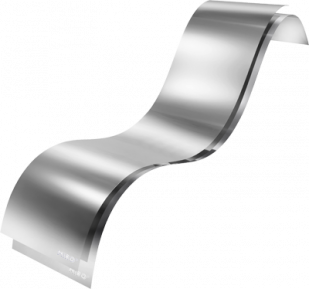Rhenium sheet, rhenium ribbon

Production
The pure metal at room temperature plastic. However, having a high modulus of elasticity, its hardness after treatment seriously increases due to work hardening. To restore ductility, rhenium annealed in hydrogen, inert gas or vacuum. Rhenium is able to withstand the heat without losing the strongholds and repeated cooling. At temperatures up to 1200 °C strength exceeds indicators of tungsten and is much higher than the strength of molybdenum. Electrical resistivity of rhenium in 4 times exceeds indicators of tungsten and molybdenum.
Rhenium sheets are produced by «hot-cold» deformation. The only difference in geometry of the semi-finished product, which is not pressed in the rod billet with a square cross-section and a flat shape of the workpiece. First, the compact metal is given the required form using standard technology, for example, bending, forging, cutting. Due to the rapid oxidation of rhenium at a temperature optimal for these actions, it is heated in a protective atmosphere, usually hydrogen, and are processed quickly.
The workpiece is heated to a high temperature, and subjected to forging, and then rolled. In order to cool the metal has not occurred, rolling is carried out at high speed. In the process of rolling used shell plating sheet with other metals. On the degree of conversion into a thin sheet decreases the temperature of rolling. Sheet after rolling has a very smooth surface, it can extrude and forge industrial products in different forms.
The sheet surface is cleaned of oxides at 1000 °C by the method of calcination in a hydrogen atmosphere or by washing in a special hot solution of caustic soda. Complex parts of rhenium can be produced by mechanical processing rhenium porous sintered blanks, pre-impregnated with copper. After sintering in vacuum of such a product the copper is removed, and rhenium compacted to 90%.
| Physical properties Re | |
|---|---|
| Atomic (molar) mass, g/mol | 186,2 |
| Oxidation | 7, 6, 5, 4, 3, 2, -1 |
| Density [g/cm3] | 21,02 |
| The melting temperature t°C | 3186°C |
| The heat of fusion kJ/mol | 34 |
| The thermal conductivity K [W/(m·K)] | 48 |
| Heat of evaporation kJ/mol | 704 |
Application
Rhenium sheet used in the metal and electrical sectors in the production of various electric heating elements with stable performance and high resistance. These elements often made of strips whose thickness is 5−20 microns. Band and ribbon serve in the production standards of resistance and compensating wires for which the commonly used tungsten-rhenium alloy.
Rhenium ribbon is used to make self-cleaning switch contacts. When closing and opening the electric circuit, the discharge oxidizes the metal at the contact. As rhenium is oxidized but its oxide is more volatile and evaporates at the level of surface of contact and the service life of the contacts significantly increases.
In instrument-making industry is also important, and other qualities of rhenium. Of rhenium alloys produced cores for the measuring equipment of highest classes of accuracy. These cores must be solid, non-magnetic and resistant to corrosion. In theodolites, levels, gyrotheodolite (surveying instruments) to stabilize the mechanical and optical nodes are used metal hangers of a very thin rhenium wire or tape. From rhenium containing single crystal Nickel alloys with increased high-temperature strength in machine building made blades of gas turbine engines.
Buy at best price
Huge range of rare and refractory metals in stock LLC «AVEK global» can satisfy any customer. Absolute compliance with all technological norms of production ensures the quality of the finished product. Deadlines all orders the shortest possible. For any questions, experienced managers will give a full detailed advice. Carrying out wholesale orders, you can count on company-provided flexible system of discounts.


